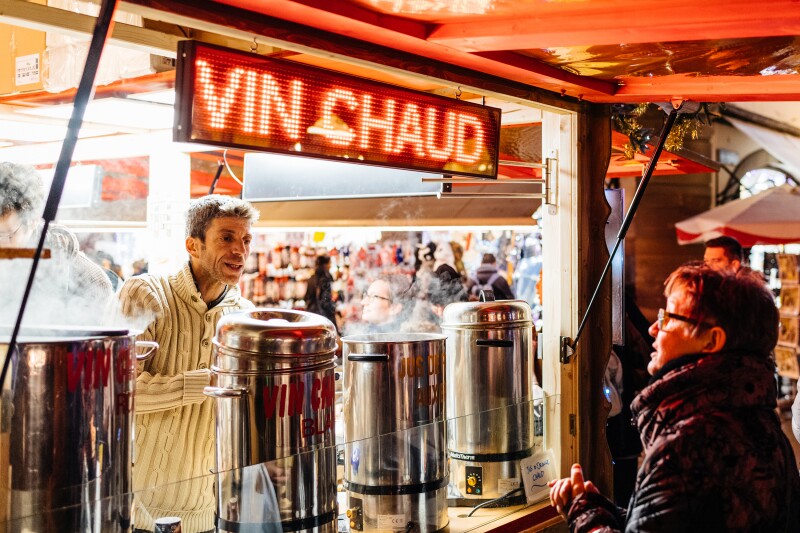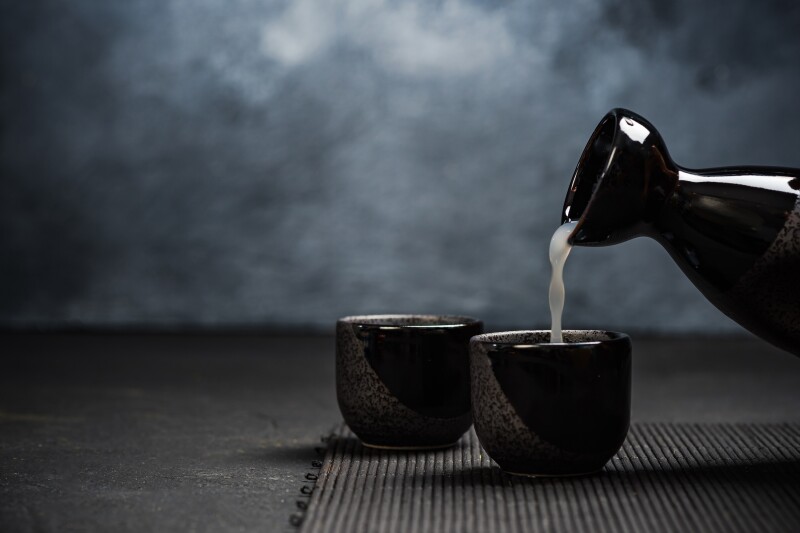Hot cocktails are easily one of the best things about the arrival of winter, and you can find them wherever temperatures are known to plummet. Even if cold weather isn’t exactly your cup of tea, traditional drinks like canelazo, caribou, and more will keep you cozy in famously frigid destinations around the world. Not going anywhere? Neither are we—but these hot winter cocktails will still transport you. Sherpa throw blanket and overstuffed armchair also recommended.

The Buena Vista in San Francisco is one of the many establishments outside of Ireland that claims to have the best Irish coffee.
Photo by Shutterstock
Irish Coffee
We often associate Irish coffee with Bailey’s coffee liqueur, but the origins of the drink are far less commercial, Andy Ferreira, general manager of Cask cocktail bar in Cork, Ireland, told us in 2018. Joe Sheridan, a chef at a restaurant in an Irish airport, created the libation after a storm left passengers stranded, hungry, and tired. He reportedly served them a mix of coffee, Irish whiskey, brown sugar, and freshly whipped cream. The drink has been beloved ever since.
At Cask, if you ask for an Irish coffee (although it’s not on the ever-changing seasonal menu), Ferreira will use demerara instead of brown sugar and tops the drink with grated tonka bean and nutmeg to give it an earthy, spiced note.
If you’re looking for a truly excellent Irish coffee, though, he says you’ll need to leave Ireland, because bartenders around the world love to play around with the recipe. Try Swift in London for a classic version that Ferreira calls a “banging good Irish coffee,” or head to the Buena Vista in San Francisco, a restaurant so committed to getting the drink right, it convinced Sheridan to emigrate from Ireland to work with it.
How to make a traditional Irish Coffee at home:
(Kilbeggan Single Grain Irish Whiskey recipe, one serving)
Ingredients:
- 1.5 parts Kilbeggan Single Grain Irish Whiskey
- 3 parts freshly brewed coffee
- Lightly whipped heavy cream
- Grated nutmeg (optional)
- 1 tbsp. brown sugar syrup
Make ahead: Mix 2 parts brown sugar and 1 part water in a small pot over medium-high heat. Bring to a simmer and stir regularly until all the sugar has dissolved. Remove from heat and allow to fully cool at room temperature; store in the fridge for up to two weeks. Optional: Add 1–2 cinnamon sticks and/or a vanilla bean for an extra kick.
Recipe:
- Preheat coffee glass by rinsing with hot water.
- Premake brown sugar syrup (see steps above) and add 1 tbsp. or .5 oz. of the syrup to the glass.
- Add 1.5 oz. Kilbeggan Single Grain whiskey to glass. Stir.
- Top off with freshly brewed coffee, leaving a half inch on top for heavy whipped cream. Stir.
- Add heavy whipped cream by pouring it gently into the glass over the back of a spoon.*
- Garnish with freshly grated nutmeg and/or cinnamon, if desired
*The secret to perfect hand-whipped cream? Use a squeeze bottle. Shake the heavy cream in the squeeze bottle for approx 30–45 seconds with 1 ice cube, until the cream feels thick and heavy in the bottle.
Hot Buttered Rum
It probably comes as no surprise that sailors had something to do with this rum-based libation. Andrew Zerrip, head bartender at New York City’s Olmsted, told AFAR that sailors brought rum from islands in the Caribbean to the American colonies, where it took on a new, hotter life. With the addition of butter, sugar, and heat, rum ceased to be simply a way to get a buzz—it became a source of energy and warmth, too.
At Olmsted, Zerrip will add a bit of spice to the basic formula: He whips cinnamon, clove, nutmeg, and allspice into butter, tops it with two different rums, and finishes the drink with grated nutmeg. If you’re interested in something experimental, he recommends heading to Dutch Kills in Long Island City for the Bear Trap—a blend of spiced butter, honey, mulled apple cider, and bourbon, frothed with a milk steamer and served in a coffee cup.
Related A Beginner’s Guide to the Dizzying World of Caribbean Rum
Sbiten
This drink has been popular in Russia since the 12th century, and its name comes from the way that it’s prepared, said Egor Kuzin, co-owner of Brimborium, a cocktail bar in St. Petersburg. “Sbiten is ‘to whip’ in Russian, thus this is a drink whipped of two parts: honey and spices,” he said.
While ancient versions of sbiten fermented the honey and spices to create a mead-like alcohol, nowadays you have to add the liquor yourself. And it can be any kind of liquor, particularly red wine, vodka, or one of the many other Russian spirits. You can even request it without alcohol if you prefer.
At Brimborium, Kuzin updated this ancient cocktail for modern customers. He whips a honey syrup with ginger, cinnamon, cardamom, and star anise and tops it with whatever liquor is requested. He recommends lesser-known Russian standbys like becherovka, samogon, or starka.
Canelazo
Icy pisco sours or caipirinha variants are common in the warmer, more tropical parts of South America, but the hot canelazo is the drink of choice in the colder southern or mountain regions of the continent.
Canelazo, a blend of aguardiente—the local moonshine—cinnamon, a type of sugar called panela, boiled cinnamon water, and sometimes juice from the citrus-flavored naranjilla fruit, is enjoyed throughout Ecuador, Colombia, Peru, and Argentina. It’s typically sold by street vendors, but you can also order the drink at many local cafés. Try the canelazo at Miskay, a restaurant in Quito, Ecuador.

The French variant of mulled wine is called “vin chaud.”
Photo by Shutterstock
Mulled Wine
It’s unclear exactly where mulled wine originated—Rome is the most likely place—but it’s now consumed all over the world. Laura Maria Marsueschke, owner of Thelonious, a cocktail bar in Berlin, told AFAR that the drink is usually a combination of red wine, citrus, sugar, spices (such as cinnamon sticks and cloves), and a brown spirit (such as rum).
It’s called glühwein in Germany, sıcak şarap in Turkey, glogg in Norway, vino navega’o in Chile, and many other names in many other places. While most countries stick to the same formula, some like to mix it up; the Moldovan version, izvar, includes black pepper and honey. Try a local version—whatever it’s called—at any of the magical markets that take place throughout Europe during the Christmas season.
Feuerzangenbowle
If you like mulled wine but wish it was a bit more festive, this is the drink for you. Often served at Christmas and during New Year’s celebrations in Germany, feuerzangenbowle is a showpiece, Marsueschke said. Wine stewed with spices like cardamom, star anise, and vanilla and mixed with oranges and almonds is served in a punch bowl and topped with a large sugar cone that is set ablaze.
The sugar cone is periodically doused with rum and drips sweet, boozy residue into the punch bowl below. It’s not a typical bar drink, but you will find it in German cities like Munich and Nuremberg, which typically host Feuerzangenbowle festivals at the end of November to kick off the holiday season.
Related Christmas Markets in Europe to Get You in the Holiday Spirit
Caribou
The name of this Canadian drink isn’t just a nod to the native animal—Emilie Beaudin, bartender at the Turbo Haüs cocktail bar in Québec City, told AFAR that legend suggests it was once made with caribou blood. But whatever the original recipe, today’s caribou is made with red wine, rye whiskey, maple syrup, and spices such as cinnamon, nutmeg, and cloves, and Beaudin says that the people of Québec have been drinking hot beverages like this one for a long time. Head to the Turbo Haüs or La Buche, a restaurant in Québec City, to try it for yourself.

To riff on a traditional hot toddy, try “sochu,” says bartender Anthony Baker.
Courtesy of Anthony Baker
Hot Toddy
While there are differing theories about the etymology of the hot toddy, the Scottish will tell you that this popular drink was named after a spring in Edinburgh called Tod’s Well, the supposed water source for early versions. Made from a mix of tea, water, honey, spices, and whiskey, the hot toddy has long been viewed as a cure for the common cold or flu. Whether or not science supports this, the drink is still widely beloved. For an updated take, head to the London cocktail bar Ladies & Gentleman for a Hot Voddy, made with apple juice, cinnamon, orgeat, and a smoky vodka. Or try a riff on it with Japanese whiskey or shochu.
How to make a Japanese Hot Toddy
(Recipe courtesy of bartender Anthony Baker, @professor.baker)
Ingredients:
- 0.5 oz. organic honey
- 0.5 oz. Yuzu lemon juice
- 6 dashes ginger bitters
- 1 oz. iichiko Saiten Shochu
- 4 oz. boiling hot water
Recipe:
Add honey, Yuzu lemon, bitters, Iichiko to glass. Add boiling water and stir. Garnish with fresh ginger, lemon wheel, cinnamon stick.

Traditionally, sake should be only slightly warmer than body temperature.
Photo by Shutterstock
Sake
A winter trip to Japan wouldn’t be complete without sake, a rice wine traditionally served warm. The original brewing method from the 3rd or 4th century gave sake some rough, woody notes, and Japanese drinkers found that warming the wine smoothed the flavors. Though sake is now more refined and often served cold, it’s still enjoyable heated ever so slightly—too much warmer than body temperature and it’s difficult to taste the nuances. Junmai, Honjozi, and Ginjo sakes are all excellent served warm.
Black Tea and Balsam
Another hot, boozy beverage popular throughout Russia, black tea and balsam is similar to a Hot Toddy. The drink is a simple combination of brewed black tea and a spirit, usually Rigas Black Balsam, a Latvian liqueur with an herbaceous flavor similar to Fernet Branca that became popular in Eastern Europe during Soviet rule, Egor Kuzin (of St. Petersburg’s Brimborium) said.
You can find the drink throughout Russia at ryumochnaya, “cheap, unpretentious vodka places” that were especially popular in the Soviet Union, he said. In Latvia, people also mix balsam with hot coffee or black currant juice.
Grog
The term “grog” (not to be confused with the Nordic mulled wine, “glogg”) has been applied to a few different alcoholic beverages in its time. Originally, it was a catchall term for any liquor cut with water. But by the 1700s, when rum was becoming more and more popular, the word increasingly referred to the mix of rum, hot water, citrus, and sugar that helped keep British sailors warm, Emilie Beaudin said, and that’s the drink most of us know as grog today.
No longer just for sailors, the drink is popular in Germany and Sweden, and it’s also a hit in France and Belgium where it’s sometimes mixed with tea. Try it at Saaldeck, a café in Berlin, or look for it at Christmas markets throughout Europe.
This article originally appeared online in November 2018; it was updated on December 2, 2019, and January 22, 2021, to include new information. Laura Dannen Redman contributed reporting.
>> Next: How to Navigate German Christmas Markets Like a Pro











